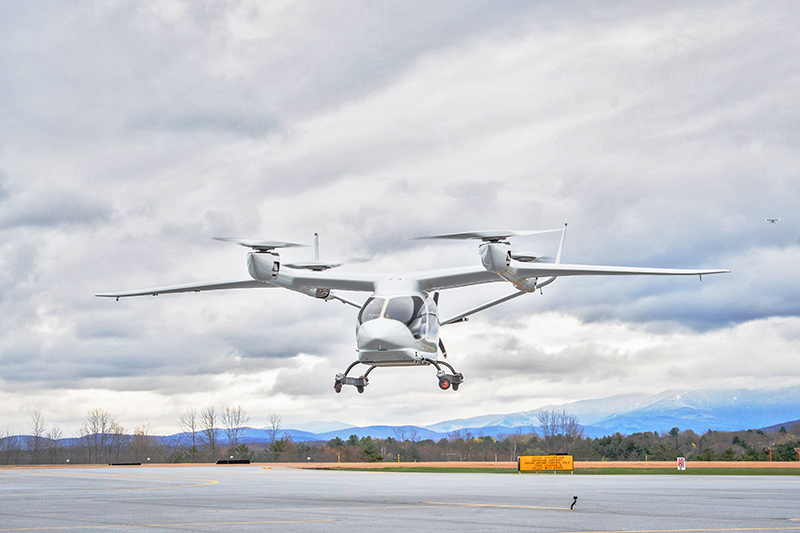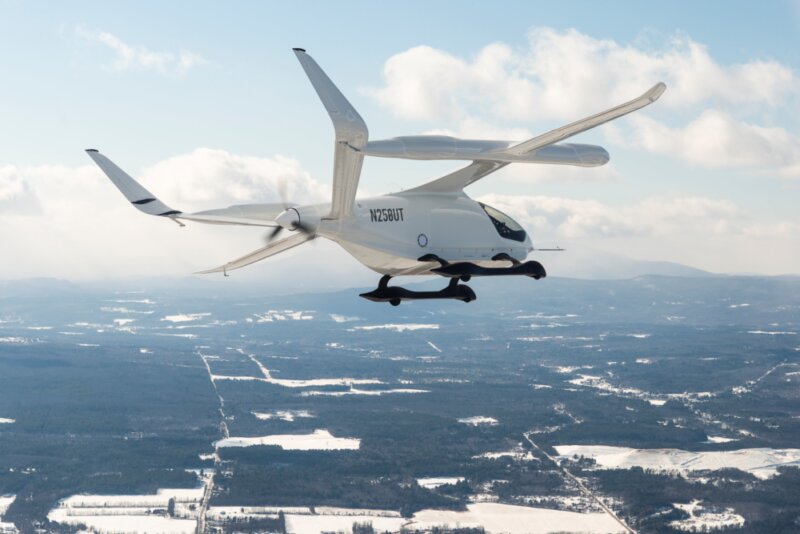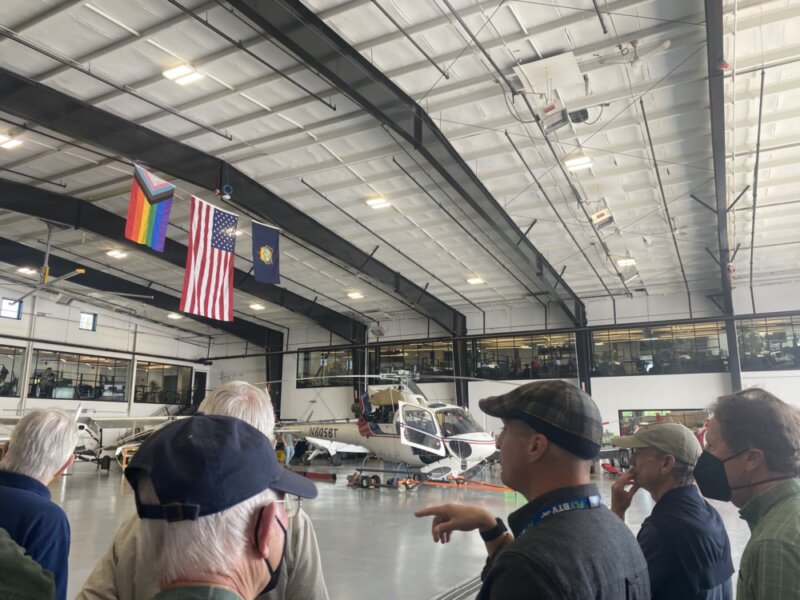BETA taking electric to new heights
This story has been edited to correct several inaccuracies.
The first electric engine was developed in Vermont. It seems only right for the first electric commercial airplane engine to be developed here, too.
If Beta Technologies has its way, that’s exactly what will happen.
A group of men who gather for breakfast at the Charlotte Senior Center were treated to a tour of the company where that magic is happening.

This is one of two electric aircraft BETA Technologies has developed. It is capable of taking off and landing vertically.
In 1834, Thomas Davenport, who lived near Brandon, invented the first electric motor. That first electric motor powered a small printing press.
The technology that Beta Technologies is working on is new and progress on the path to electric commercial flight is happening fast. In fact, just the day before the tour the company had moved a critical step forward in the FAA’s long and exacting approval process for new aircraft.
That approval step was for a powered-lift category of aircraft; in other words, planes that can takeoff and land vertically and then fly horizontally, Tyler Seeholzer of Beta Technologies said. These are called eVTOL for electric vertical takeoff and landing.
Seeholzer said he uses the term electric magic to explain how spinning magnets generate electrical energy that can be converted into mechanical energy.
“People laugh and they smile when I say that, but nobody has yet to define magnetism to me in a way that I can fully understand,” he said.
Besides eVTOL, BETA has designed and is working on certification for commercial electric planes that take off and land horizontally. Vertical takeoff requires lots of energy and severely depletes battery storage, leaving it with less flight time.
But vertical takeoff is important to the company because one of its first customers is United Therapeutics, which develops life-extending technologies for lung disease and organ transplants. It would use these aircraft to deliver synthetic organs for transplants.
Both planes are all electric with zero emissions while flying and BETA is testing prototypes of both almost daily.

The company has flown a traditional landing prototype from Jamestown, N.Y., to Plattsburgh. At 386 miles, Seeholzer said they think this is the longest electric flight ever. BETA Technologies goal is for the planes to have a range of around 250 miles when taking off and landing conventionally.
A traditional commercial aircraft will burn at least 500 pounds of gas an hour. On an average flight it will weigh around 30,000 pounds when it takes off and about 15,000 pounds when it reaches its destination, he said.
“Nobody ever asks where that 15,000 pounds of stuff goes,” Seeholzer said. “If I took a swimming pool full of gas, and I filled it up with the same amount of fuel that you put in that plane and lit it on fire, you couldn’t find the one person that wouldn’t be outraged.”
That’s an environmental disaster that’s repeated over and over again every single day, he said. The electrified plane weighs the same when it lands as when it took off.
With just three moving parts — a stationary stator with wound magnets, a rotating rotor and a shaft that ultimately connects to the aircraft’s propeller — the life of an electric plane engine will be much longer than conventional aircraft engines.
Electric engines weigh so much less. Seeholzer said that, if they were to develop a traditional combustion engine for vertical lift, it would have to weigh thousands of pounds, while the electric engines the company is developing weigh much, much less.
The eVTOL has five of those engines, four that provide vertical lift and a fifth that pushes the plane horizontally once it’s reached height, while the conventional horizontal takeoff and landing plane they are testing has just one horizontal pushing engine and weighs very little.

The batteries come from other sources, but Beta Technologies packages them. Each of these battery packs is a rectangular box a bit larger than a big, standard suitcase. Each pack goes to a different propellor engine and they are not connected, so a problem with one does not travel to other battery packs.
These battery packs are filled with lots of independent batteries instead of being one giant battery. The advantages to this include not losing power if one battery cell is worn out and in getting approval from the Federal Aviation Administration for their groundbreaking aircraft.
“Milwaukee’s been doing it for years. That cell technology has a great track record with some science behind it,” Seeholzer said. “Today, our chief focus is certifying a plane, so we take reliable, predictable technology.”
That’s not to say they won’t change battery technology in the future. In fact, Beta Technologies has a battery research facility in the old Duracell facility in St. Albans
It takes under an hour to recharge the batteries on the planes, but if a plane is needed faster than that, the battery pack can just be pulled out and replaced with a charged battery pack.
The researchers of BETA Technologies took test flights to Bentonville, Ark., in a conventional aircraft and in one of their electric planes. The flight was not direct and done in legs. Each leg of the flight cost an average of $700 for the conventional plane, while it cost about $17 for the electric plane.
In the race to be first, Beta Technologies is feeling confident because all of their largest competitors are just flying remote-controlled test electric planes with no humans on board, not even the pilot. “Yet Kyle Clark, our CEO, flies flight tests two or three times a week inside our aircraft,” Seeholzer said.
In order to keep weight down and have the potential to carry the most cargo, the planes the company is working on now are planned for just one person, the pilot. However, he said, they are building dual-control training prototypes of the aircraft where a pilot rated for training can sit beside a trainee and take over the controls if needed.
United Parcel Service (UPS) has ordered 10 vertical takeoff and landing airplanes to be delivered next year which it plans to have fly directly to and from its facilities rather than use airports.
The company’s intent is to have its eVTOL aircraft certified in 2026.
That’s a pretty fast development for the company that Kyle Clark of Essex founded in 2017, developing its first aircraft with eight people in 10 months.
Now there are about 500 people employed by the company. Its biggest facility is next to the airport in South Burlington, but it also has almost a dozen sites from Montreal to New York to Washington, D.C. It is also building charging infrastructure at dozen of sites from Vermont to Georgia to Arkansas.
Although he expects the company to continue expanding into lots of other areas, he doesn’t see it leaving Vermont.
“This is a Vermont company by Vermonters for Vermonters. If we’re going to demonstrate rural capability, we’re not going to do it in the Nevada desert the way everybody else is. We’re going to do it right here,” he said.
While money is critical to the future of BETA Technologies, Seeholzer said, “We’re not trying to make money. We’re trying to quite literally change an industry. We’re not allergic to money, but it’s not the driving factor.”
